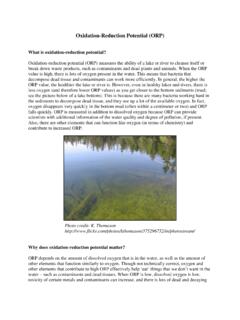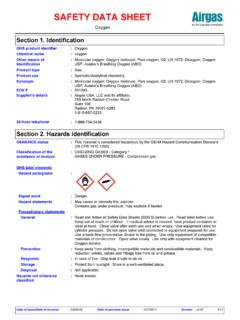Transcription of Conductivity - Gov
1 Conductivity What is Conductivity ? Just like metal, water can conduct (transport) electricity. This is because there are salts dissolved in the water. If you have pure water with absolutely no salts, electricity will not be conducted and Conductivity will be 0. When we measure Conductivity , we are measuring how easily electricity is flowing through the water and we get an indirect estimate of how many salts are in the water. The salts come from rocks that have been broken down by water flowing over them, and the types of rock and soil around waterbodies control Conductivity . Rocks that do not get broken down easily cover most of the Canadian Shield and there is very little soil in this region.
2 As a result, lakes on the Canadian Shield (like the one pictured below, on the left) do not have high Conductivity . In contrast, rich soils and relatively soft rocks are common on the plains of Alberta. As a result, many Alberta lakes have high Conductivity (for example, the lake pictured below, on the right). Conductivity also depends on the temperature of the water. As water temperatures increase, Conductivity increases. Also, if lakes do not receive enough rain or stream water, Conductivity increases. This is because evaporation takes water away but does not take salts away. As lakes dry up, the saltiness ( Conductivity ) of the remaining water increases.
3 Photo credit: Jenny Graydon Photo credit: Craig Emmerton Why does Conductivity matter? Conductivity is an indirect measure of the saltiness of the water. Fish and other organisms that live in freshwater cannot tolerate large increases in the saltiness of the water because they will not be able to keep water in their bodies. Fish and animals that live in saltier water such as in the ocean are adapted to these environments and can survive. Climate change may increase the saltiness of freshwater lakes if warmer conditions increase evaporation. This could result in stress to fish and other animals that live in water.
4 Pollution can also increase Conductivity of lakes and rivers because industrial and human wastewaters often have high Conductivity . However, not all industrial activities will increase water Conductivity . For example, oil does not conduct electricity well, so water pollution by oil would not be detected by measuring water Conductivity . Low Conductivity (0 to 200 S/cm) is an indicator of pristine or background conditions. Mid range Conductivity (200 to 1000 S/cm) is the normal background for most major rivers. Conductivity outside this range could indicate that the water is not suitable for certain species of fish or bugs.
5 High Conductivity (1000 to 10,000 S/cm) is an indicator of saline conditions. Waters that have been heavily impacted by industry can fall into this range. How do we measure Conductivity ? Conductivity is best measured directly in the lake or river. Collecting a sample and measuring it later is not as good because the temperature of the water obviously changes when it is in a bottle and we mentioned earlier that temperature affects Conductivity . When you place a Conductivity sensor in the water, a mild electrical current is passed between two electrodes. Conductivity is measured in this way and recorded in units called micro Seimens per centimeter of water ( S/cm).
6 If you measure an increase in S/cm, you are measuring an increase in Conductivity of the water. References/For More Information Environment Canada Horne, A. J., and Goldman, C. R. 1994. Limnology, 2nd edition. McGraw-Hill, Inc. 576 pp. Conductivity . Wetzel, R. G. 1983. Limnology, 2nd edition. Saunders College Publishing. 760 pp.










